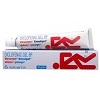 Pill Categories
Pill Categories
Diclofenac Gel
 |
Diclofenac Gel is a topical NSAID cream that is used to cure the inflammation and pain caused by certain conditions (knee and joint pain caused by osteoarthritis). |
PRODUCT DESCRIPTION, SAFETY, ETC View product image
Diclofenac Gel 30 g

PRODUCT DESCRIPTION
Drug Name
Diclofenac Gel (Diclofenac)
Drug Uses
Diclofenac Gel is used for treating pain in certain joints (e.g., in the knees or hands) caused by osteoarthritis. It may also be used for other conditions as determined by your doctor.
How to use
Use Diclofenac Gel as directed by your doctor.
- Do not apply Diclofenac Gel to infected skin; open wounds; or red, swollen, or peeling skin.
- Use the provided dosing card to measure your dose of Diclofenac Gel. Ask your pharmacist if you have any questions about how to use the dosing card or Diclofenac Gel;
- Gently massage Diclofenac Gel into the skin of the affected area. Allow the medicine to dry for at least 10 minutes before you wear clothes or gloves over the treated area.
- After using the dosing card, fold it in half (with the used side inside) and throw it away out of the reach of children and pets.
- Wash your hands immediately after using Diclofenac Gel unless your hands are part of the treated area.
- Do not wrap, bandage, or apply heat to the treated area.
- Do not shower, bathe, or wash the treated area for at least 1 hour after you use Diclofenac Gel.
Ask your health care provider any questions you may have about how to use Diclofenac Gel.
Drug Class and Mechanism
Diclofenac Gel is an NSAID. It may work by blocking certain substances in the body that are linked to inflammation. NSAIDs treat the symptoms of pain and inflammation. They do not treat the disease that causes those symptoms.
Missed Dose
If you miss a dose of Diclofenac Gel, skip the missed dose. Go back to your regular dosing schedule. Do not use 2 doses at once.
Storage
Store Diclofenac Gel at room temperature, between 68 and 77 degrees F (20 and 25 degrees C). Store away from heat, moisture, and light. Do not store in the bathroom. Keep in a tight, light-resistant container. Keep Diclofenac Gel out of the reach of children and away from pets.
Precautions
Discuss with your doctor about any prior medical condition that you may have including allergies to medicines, food or other substances.
Diclofenac Gel may cause drowsiness. These effects get aggravated if you take it with alcohol or certain other medications (sleep aids, muscle relaxers). So, do not drive or perform other potentially hazardous tasks until you know how your body reacts to the drug.
The GEL is for external use only. Avoid exposure to your eyes, nose and mouth. If exposed, rinse immediately with cool water.
Do not use aspirin, sunscreens, lotions, insect repellants, or other topical medicines on the affected area that has been treated with the GEL, or expose the area to sun, sunlamps, or tanning booths.
Some patients develop serious stomach ulcers or bleeding with the use of Diclofenac Gel. Using it in high doses, for a long time, smoking, or drinking alcohol increases the risk of these side effects.
If you develop severe stomach or back pain, black, tarry stools, vomit that looks like blood or coffee grounds, or unusual weight gain or swelling, contact your doctor or emergency room right away.
You must not take if you are allergic to any ingredient in it or had a severe allergic reaction (e.g., severe rash, hives, trouble breathing, growths in the nose, dizziness) to aspirin or an NSAID (e.g., celecoxib, ibuprofen), have recently had or will be having bypass heart surgery, have severe kidney problems, are in the last 3 months of pregnancy.
If you are pregnant or suspect that you are, then stop using Diclofenac Gel and contact your doctor immediately.
Certain drugs (NSAIDs) can interact with Diclofenac Gel and hence, mention clearly to your doctor or pharmacist all medicines, dietary supplements and herbal prescriptions that you are taking.
It is unknown whether Diclofenac GEL is secreted in breast milk. Avoid breast feeding while using the drug.
Periodic lab tests including kidney function, complete blood counts, and blood pressure may be recommended to monitor your health while taking the drug. Ensure that you do not miss any lab tests.
Side Effects
Some of the common side effect of Diclofenac Gel is mild irritation at the application site. Please contact your doctor if the symptoms persist or become bothersome.
Other severe side effects include allergic reactions (rash, hives, itching, trouble breathing, tightness in the chest, swelling of the mouth, face, lips, or tongue), bloody or black, tarry stools, change in the amount of urine produced, chest pain, confusion, dark urine, depression, fainting, fast or irregular heartbeat, fever, chills, or persistent sore throat, mental or mood changes, numbness of an arm or leg, one-sided weakness, red, swollen, blistered, or peeling skin, ringing in the ears, seizures, severe headache or dizziness, severe or persistent irritation at the application site, severe or persistent stomach pain or nausea, severe vomiting, shortness of breath, sudden or unexplained weight gain, swelling of hands, legs, or feet, unusual bruising or bleeding, unusual joint or muscle pain, unusual tiredness or weakness, vision or speech changes, vomit that looks like coffee grounds, yellowing of the skin or eyes.
You must seek medical attention immediately if any of these side effects occur.
More Information
Diclofenac Gel is to be used only by the patient for whom it is prescribed. Do not share it with other people.
If your symptoms do not improve or if they become worse, check with your doctor.
| Home Contact us Delivery Control Discounts Sitemap | Terms of service | Money back policy | Privacy policy |








 Live Chat 24/7
Live Chat 24/7






